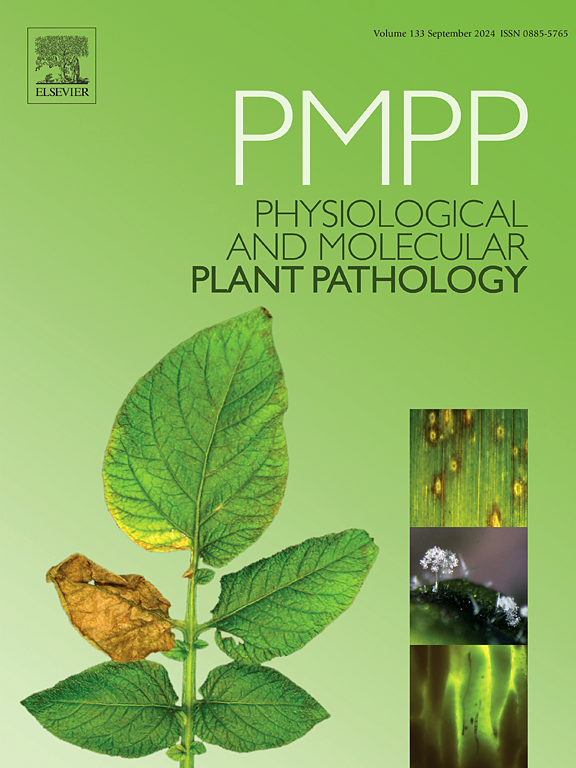Efficacy of Pseudomonas aeruginosa and Trichoderma asperellum in promoting plant growth and suppression of Ganoderma boninense disease infestations in oil palm
IF 2.8
3区 农林科学
Q2 PLANT SCIENCES
引用次数: 0
Abstract
The most common disease affecting Malaysian palms is basal stem rot (BSR), which is caused by Ganoderma species. Pre-inoculation of oil palm seedlings with Trichoderma asperellum and/or Pseudomonas aeruginosa was conducted to study their effects on the vegetative development and BSR disease suppression. A 32-week nursery trial was conducted on four-month-old oil palm seedlings (D × P) utilizing the dip, place, and drench (DPD) artificial inoculation technique. Disease severity (DS) was determined by root symptoms in conjunction with the influence of vegetative growth. In addition, root samples were collected at eight months after inoculation (MAI) and analyzed using GC-MS to investigate the expression of metabolites generated as a defensive response to G. boninense infection. Using BCAs helped oil palm seedlings grow better than those that weren't treated. The single application of T. asperellum and the combination of P. aeruginosa and T. asperellum had the greatest impact on the growth of the oil palm seedling's plant height (143.0 cm ± 0.02) and (140.45 cm ± 0.02), respectively. Seedlings infected with G. boninense and treated with a mixture of BCAs had the highest top and root weight and the lowest DS (50 %), compared to seedlings infected with G. boninense (positive control) (83.3 %). Furthermore, GC-MS analysis revealed that treatment with BCAs produced plant secondary metabolites that may be involved in antimicrobial and plant defense systems, and as plant growth promoters.
铜绿假单胞菌和曲霉木霉促进油棕植株生长和抑制牛灵芝病的效果研究
影响马来西亚棕榈树的最常见疾病是基底茎腐病(BSR),这是由灵芝物种引起的。采用油棕幼苗预接种曲霉木霉和铜绿假单胞菌,研究其对油棕幼苗营养发育和BSR病抑制的影响。以4月龄油棕幼苗(D × P)为研究对象,采用浸、放、淋(DPD)人工接种技术进行了32周的苗圃试验。疾病严重程度(DS)由根系症状和营养生长的影响共同决定。此外,在接种后8个月采集根样品,并使用GC-MS分析作为防御应答的代谢物的表达。使用bca可以帮助油棕幼苗比未处理的幼苗生长得更好。单施曲霉和铜绿假单施曲霉对油棕幼苗株高的影响最大,分别为(143.0 cm±0.02)和(140.45 cm±0.02)。与阳性对照(83.3%)相比,经bca混合处理的牛牛肉牛幼苗顶重和根重最高(50%),DS最低(50%)。此外,GC-MS分析显示,BCAs处理产生的植物次生代谢物可能参与植物的抗菌和防御系统,并作为植物生长促进剂。
本文章由计算机程序翻译,如有差异,请以英文原文为准。
求助全文
约1分钟内获得全文
求助全文
来源期刊
CiteScore
4.30
自引率
7.40%
发文量
130
审稿时长
38 days
期刊介绍:
Physiological and Molecular Plant Pathology provides an International forum for original research papers, reviews, and commentaries on all aspects of the molecular biology, biochemistry, physiology, histology and cytology, genetics and evolution of plant-microbe interactions.
Papers on all kinds of infective pathogen, including viruses, prokaryotes, fungi, and nematodes, as well as mutualistic organisms such as Rhizobium and mycorrhyzal fungi, are acceptable as long as they have a bearing on the interaction between pathogen and plant.

 求助内容:
求助内容: 应助结果提醒方式:
应助结果提醒方式:


